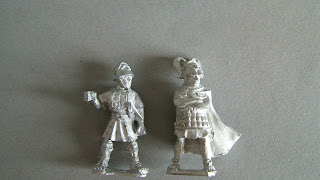As the last units of Spartans are slowly taking shape the creative spark is drawn to other sources. The impetus driving the Spartans was the Battle of Mantinea with the 400 point army depicted and painted representing the victorious force of that bloody day. The inspiration that will drive the Macedonians on will be taken from Arrian as below:
But to this Alexander replied, "I recognize the force of these arguments, O Parmenio; but I should feel it a disgrace, if, after crossing the Hellespont so easily, this paltry stream (for with such an appellation he made light of the Granicus) should bar our passage for a moment. I consider that this would be in accordance neither with the fame of the Macedonians nor with my own eagerness for encountering danger. Moreover, I think that the Persians will regain courage, in the belief that they are a match in war for Macedonians, since up to the present time they have suffered no defeat from me to warrant the fear they entertain."
Having spoken thus, he sent Parmenio to take the command upon the left wing, while he led in person on the right. And at the head of the right wing he placed the following officers: Philotas, son of Parmenio, with the cavalry Companions, the archers, and the Agrianian javelin-men; and Amyntas, son of Arrhabaeus, with the cavalry carrying the long pike, the Paeonians, and the squadron of Socrates, was posted near Philotas. Close to these were posted the Companions who were shield-bearing infantry under the command of Nicanor, son of Parmenio. Next to these the brigade of Perdiccas, son of Orontes; then that of Coenus, son of Polemocrates; then that of Craterus, son of Alexander; then that of Amyntas, son of Andromenes; finally, the men commanded by Philip, son of Amyntas. On the left wing first were arranged the Thessalian cavalry, commanded by Calas, son of Harpalus; next to these, the cavalry of the Grecian allies, commanded by Philip, son of Menelaus; next to these the Thracians, commanded by Agatho. Close to these were the infantry, the brigades of Craterus, Meleager, and Philip, reaching as far as the centre of the entire line.
The actual army list has still to be finalised but the above passage will provide the historical basis of the army as well as the inspiration to paint it. At first glance this force will have at least six phalanx in it, so there will be a good few pikemen to paint as well as several units of cavalry. This doesn't include the skirmishers and light infantry mentioned as well. Oh the joys! When the full list is completed it will be posted to the Macedonian page.
Cheers for now.





